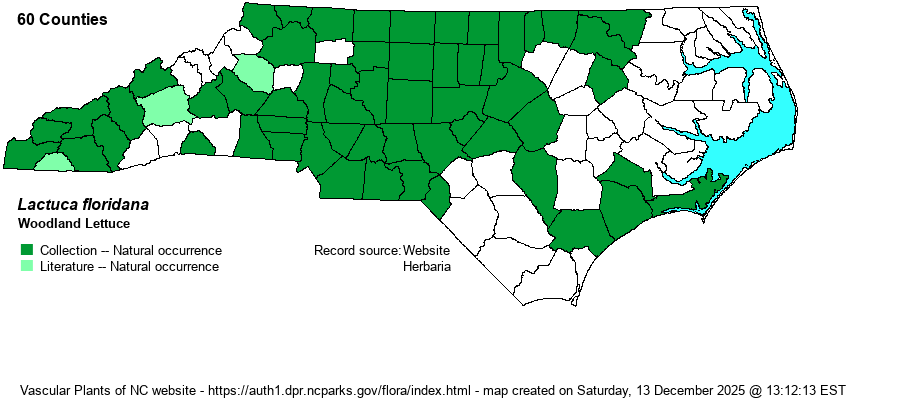| Author | (L.) Gaertner | |
| Distribution | Mountains, Piedmont, and scattered on the Coastal Plain; scarce in the Sandhills and absent in the far eastern counties. The large gaps in the Coastal Plain are likely to get smaller with additional collecting.
NY to MN, south to FL and TX. | |
| Abundance | Fairly common in the Piedmont; uncommon in the Mountains and in parts of the western and central Coastal Plain; very rare to absent in the eastern Coastal Plain. | |
| Habitat | Mesic to moist soil of bottomlands and floodplains, rocky shores of rivers, pine-deciduous forests and woodlands, meadows. This is a rather forest-based Lactuca, though it can be seen along borders and in openings. |
| Phenology | Flowering and fruiting August-October. | |
| Identification | Woodland Lettuce is easy to overlook, as its populations typically are only 1-5 plants. Among our 3 blue-flowered species, this one and L. biennis have well-developed stem leaves (vs. nearly all basal in the slender-leaved L. graminifolia). Woodland Lettuce has white pappus, whereas Tall Blue Lettuce (L. biennis) has tawny (pappus are the feathery hairs attached to the seed). It has only 10-15 flowers per head vs. 20-30 in a head for L. biennis; thus, the flowers have fewer rays than on the more "floriferous" L. biennis. It also has leaves without clasping bases, whereas Tall Blue Lettuce has clasping leaves. The latter is primarily a montane species, but the ranges of the two overlap. Both are very tall (often over 6 feet tall), and striking in bloom with the light lavender-blue flowers. Though widespread in range (number of counties), it does not grow in colonies and thus does not create a spectacular floral show. | |
| Taxonomic Comments | None
| |
| Other Common Name(s) | Florida Blue Lettuce, False Lettuce | |
| State Rank | S4? [S5] | |
| Global Rank | G5 | |
| State Status | | |
| US Status | | |
| USACE-agcp | FACU link |
| USACE-emp | FACU link |

